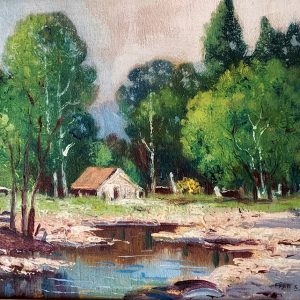calsfoundation@cals.org
Frederick Ernest Swedlun (1877–1959)
aka: Ernest Fredericks
Frederick Ernest Swedlun, best known pseudonymously as Ernest Fredericks, was a prolific early twentieth-century artist active in Arkansas and Illinois and throughout the Ozarks region. His colorful woodland landscape paintings captured the rustic beauty of the area during every season of the year. One example, Autumn in the Ozarks, painted of a scene near Rogers (Benton County), was exhibited at the Chicago Art Institute in June 1940.
Frederick Swedlun was born of Swedish parents, Olof Swedlun and Christine M. Sandahl, on a farm near McPherson, Kansas, on February 8, 1877. According to Swedlun’s autobiographical sketch, the farm life was not appealing to him. He moved to Chicago, Illinois, and began study at the Chicago Academy of Fine Arts. It was there that he created the pseudonym Ernest Fredericks, a modified reversal of his first and middle names, in an apparent attempt to minimize anti-immigrant prejudice then directed at those of Swedish origin.
Swedlun was influenced by Western American master painter Birger Sandzen, a Swedish artist and fellow Kansan. Swedlun developed his talent by constant practice, observation, and analysis. But it was nature itself, he said, that inspired him. He studied many different moods, developing through experience a technique entirely his own. His subjects were simple, often a forest path, a stream, a country road, or mountain cabin.
Swedlun married Cordella Florence Cayle on May 26, 1900, in Kane, Illinois. They had two children, a son and daughter. His son, Glenn Swedlun, became a landscape painter of considerable talent himself.
Following his studies at the Chicago Academy of Fine Arts, Swedlun exhibited at the Art Institute of Chicago and in the All-Illinois art shows. He belonged to the Chicago Society of Artists. Swedlun’s paintings were often accompanied by either a typed biographical sketch or a reprint of a 1940 edition from the Chicago Daily News pertaining to a Swedlun exhibition. Typically, on these printed sources, Swedlun would add a handwritten title for the painting and a description of where it was painted.
Swedlun found endless inspiration in the beauty of the Ozarks. In Chicago, Swedlun described the Ozarks as an “artist’s gold mine of color and composition.” In 1950, Swedlun and his wife, along with his son and daughter-in-law, moved to Eureka Springs (Carroll County). There, he resumed signing his art with his actual name, Fred Swedlun. Together with his son, Swedlun painted and taught art classes in the Ozarks until his death.
Biographical and portfolio citations for Swedlun are listed in Davenport’s Art Reference, The Artists Bluebook, Who Was Who in American Art, 1564–1975, The Annual Exhibition Record of the Art Institute of Chicago, and the Index of Artists: International-Biographical. His works have been included in the Ogden Museum of Southern Art, the State of Illinois permanent art collection, the Eureka Springs Historical Museum, and many private collections throughout the country.
Swedlun died on February 5, 1959. He is buried in the Independent Order of Odd Fellows Cemetery in Eureka Springs. In 2010, as a part of the Twenty-third Annual Festival of the Arts, the Eureka Springs Historical Museum displayed a group of paintings by Swedlun and his son. The collection, in part, had been donated to the museum by the Swedlun estate and became a permanent exhibit at the museum.
For additional information:
Craig, Susan V. Biographical Dictionary of Kansas Artists (Active before 1945). 2009. http://kuscholarworks.ku.edu/dspace/bitstream/1808/1028/4/BDKAversion2.pdf (accessed October 14, 2021).
“Ernest T. Fredericks (1877–1959).” AskART.com. http://www.askart.com/askart/artist.aspx?artist=116878 (accessed October 14, 2021).
Glenn C. Swedlun Art Collection. Eureka Springs Historical Museum, Eureka Springs, Arkansas.
Thomas A. Teeter
Little Rock, Arkansas
 World War II through the Faubus Era, 1941 through 1967
World War II through the Faubus Era, 1941 through 1967 Autumn in the Ozarks
Autumn in the Ozarks  Near Eureka Springs
Near Eureka Springs 




Comments
No comments on this entry yet.